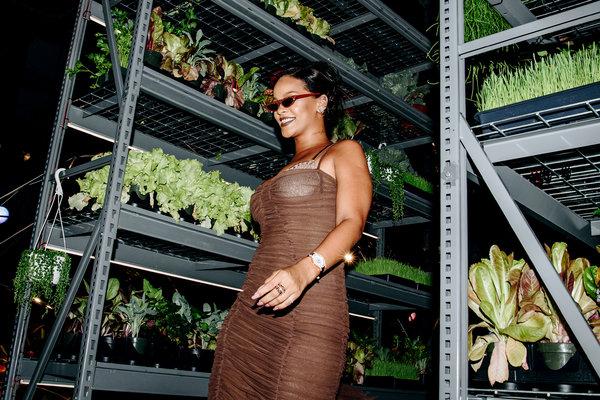
Rihanna at her Savage x Fenty show in New York in 2018.CreditNina Westervelt for The New York Times
Get ready for the second coming of Fenty.
On Friday, LVMH Moët Hennessy Louis Vuitton, the world’s largest luxury group, officially confirmed not only that the fashion line created by Rihanna was becoming part of its gilded stable, but also that the first products from the new company would be unveiled — in a few weeks. Thus the disruption of the status quo begins.
Rihanna will become the first woman to create an original brand at LVMH, the first woman of color at the top of an LVMH maison, and her line will be the first new house created by the group since Christian Lacroix in 1987. It joins such storied heritage brands as Dior, Givenchy, Celine and Fendi and positions Rihanna as a breakthrough designer on a number of levels.
The move is a formal acknowledgment from the establishment that a multi-hyphenate pop star/actress/image-maker now has as much global currency, name-recognition and (yes) influence as designers like Hedi Slimane and Nicolas Ghesquière. That there is no need to limit them to the street or sportswear world. And that growth in the luxury industry may no longer come just from reinventing old heritage names, but by embracing a new diverse, digital, direct communication-enabled reality.
The brand, whose logo features a graphic representation of Fenty that resembles a Greek key design, as well as the name in white letters against a blue background with a reversed “N,” will be based in Paris, include ready-to-wear, shoes and accessories, and “is centered on Rihanna, developed by her, and takes shape with her vision,” according to a statement from LVMH.
It is, in other words, the first brand of the Instagram age supported by one of the three big groups that have defined the global luxury era.
“Designing a line like this with LVMH is an incredibly special moment for us,” Rihanna, 31, said in the statement. “Mr. Arnault has given me a unique opportunity to develop a fashion house in the luxury sector, with no artistic limits. I couldn’t imagine a better partner both creatively and business-wise, and I’m ready for the world to see what we have built together.”
The news of a deal between LVMH and Rihanna, whose full name is Robyn Rihanna Fenty, was originally leaked in January, but this is the first time either party has spoken about their agreement. It marks an evolution in the celebrity-style synergy, which has progressed from one-off collaborations (Selena Gomez and Coach) to longer term deals between sports brands and stars (Beyoncé and Adidas) to, now, the sort of brand that Emilio Pucci built.
“Everybody knows Rihanna as a wonderful singer, but through our partnership at Fenty Beauty, I discovered a true entrepreneur, a real C.E.O. and a terrific leader,” Bernard Arnault, the chairman of LVMH, said in the statement, referring to the partnership Fenty has had with LVMH since 2017 to create and distribute its beauty line.
“She naturally finds her full place within LVMH,” he continued. “To support Rihanna to start up the Fenty Maison, we have built a talented and multicultural team supported by the Group resources.”
The Group resources are notably large — LVMH reported first quarter revenues in April of 12.5 billion euros ($14.1 billion), an increase of 16 percent — and the emphasis on “multicultural,” in a time when many luxury brands are suffering from charges of cultural insensitivity and discrimination, is significant.
LVMH has been making strides in recent years to right the gender balance in luxury, appointing the first female designers of Givenchy in 2017 and Dior in 2016. It has also begun to address the need for diversity, naming Virgil Abloh as the first African-American to head Louis Vuitton men’s wear in 2018.
Fenty, however, has made inclusivity of all kinds — size, race, gender identity — part of its identity from the beginning.
Founded in 2016 under an agreement with Puma, which was then owned by the LVMH rival Kering (the brand was originally called Fenty x Puma), Fenty had its debut at New York Fashion Week before moving to Paris for two seasons and unexpectedly charming the normally suspicious French fashion world with the kind of clothes that, she said at the time, “Marie Antoinette would wear if she was going to the gym.”
In 2017, it returned to New York for a show at the Park Avenue Armory that featured freestyle motocross racers zooming around a runway and doing tricks over mounds of sparkly pink sand, demonstrating that when it comes to spectacle (and LVMH loves a fashion show spectacle), Rihanna can hold her own with any marketing machine. Last year she expanded the line to lingerie with Savage x Fenty.
A Behind the Scenes Look at Rihanna’s Fenty x Puma Show
26 Photos
View Slide Show ›
Though she has not shown ready-to-wear on the runway since September 2017, there is no reason to expect the new version of Fenty will be significantly different from the old, though presumably it will benefit from the manufacturing and materials savoir-faire of LVMH.
In other words, expect haute streetwear of many sizes and shades.
Both parties declined to comment further on the plans for a show or stores, but the inclusion of a website — fenty.com — in the statement suggested that the focus, for the beginning at least, would be digital, yet another departure for a group that practically invented the concept of the flagship as brand temple.
LVMH’s first foray into original couture, Lacroix, did not end too well; it sold the brand in 2005, and the name is now largely associated with an unrelated sparkling water. Whether this story will rewrite the playbook of luxury remains to be seen. But the first chapter is about to begin.







